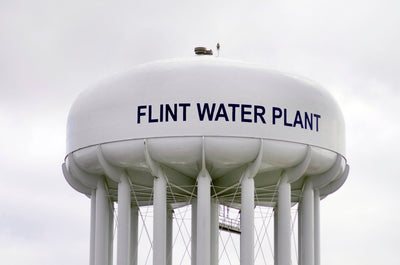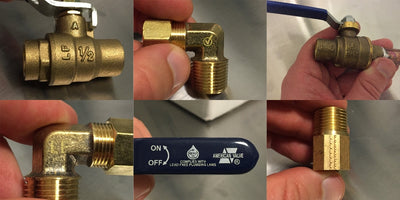Water Quality InformationWritten By Actual Experts
RSSIncome, Race, and The Availability of Safe Drinking Water in Two Michigan Cities

Michigan to Pay Over $600 Million to Families in Flint

Updated November 17, 2021 to include recent news
Analies Dyjak, M.A. | Policy Nerd
A judge has approved a $626 million settlement for damages from the 2014 Flint Water Crisis. The State of Michigan is required to appropriate $600 million dollars of the total into a qualified settlement fund, which will be made available to children, residents, property owners, and businesses that were impacted by water distributed by the city. Almost 80% of the $600 million is being awarded to those who were children during the time of exposure.
Background Flint Water Crisis:
On April 25, 2014, the city of Flint switched its water supply from the Detroit Water and Sewerage Department (sourced from the Detroit River and Lake Huron), to the Flint River. Officials initially switched the water supply in an effort to cut costs. Flint city officials failed to add a proper corrosion control inhibitor to the new water source during treatment. This caused lead to leach from distribution pipes, and enter the municipal system at extremely elevated levels. According to the Centers for Disease Control, 99,000 people in Flint, Michigan were exposed to elevated levels of lead. Lead is a neurotoxin, and according to the American Academy of Pediatrics, there is NO safe level for children. Despite the current 15 part per billion Federal Action Level for lead, our team at Hydroviv follows the logic that children should not ingest any level of lead.
Financial Breakdown of $600 Million Flint Settlement:
-
79.5% - Minor Children Settlements Categories: 64.5% for ages 6, 10% for ages 7-11, and 5% for ages 12-17
-
18% - Adults and Property Damage Settlement Categories: 15% for adults and 3% for property damage
-
0.5% - Business Economic Loss Settlement Category
-
2% - Programmatic Relief Settlement Category
Important Details:
If the State fails to meet these conditions within 60 days, the Plaintiff’s are able to completely rescind the entire settlement. Also, in accordance with the settlement, individuals who were minors at the time of exposure are not required to show proof of injury in order to be eligible for compensation. This should help the State of Michigan get funds out to impacted parties in a timely manner. Additionally, individuals that were minors at the time of exposure may be eligible for larger amounts of compensation if they are able to show elevated blood lead levels. A similar eligibility requirement is true for those who were adults at the time of exposure.
A Few Red Flags:
The amount of compensation made available to each individual Flint resident is entirely dependent on how many people file claims. Therefore, there’s no way to estimate the amount of money each Flint resident will receive, or if it will be sufficient enough to address all expected damages. The settlement also claims that funding will be made available to provide special education services to children exposed to high lead levels Flint. No further details were provided about these special education services or how much funding will be allocated. It's unclear if portions, or all, of the individual financial compensation funds are expected to be used for at-home special education services.>
Our Take:
The recent settlement leaves us with more questions than answers regarding the tragic Flint Water Crisis. What happened between April 24, 2014 and December 31, 2016 demonstrates what can happen to under-served and underrepresented communities in the United States. In short, it shows the worst kind of government failure. We may never truly understand the full extent of these damages, and $600 Million dollars does not even begin to address the trauma and anxiety that Flint residents face every single day. We're proud to still be working with Little Miss Flint and the Little Miss Flint Clean Water Fund to continue our charitable efforts across the entire country.
Other Articles We Think You Might Enjoy:How Does Lead Enter Drinking Water?
What You Need to Know About Disinfection Byproducts in Tap Water
How Did Hydroviv Perform in a Duke University PFAS Removal Study?
Error Found In Media Coverage Of Hydroviv's Flint Donation Program
Hey Everyone,
I came across an article tonight where there was an inaccurate figure about the number of filters that Hydroviv (which was just me at the time) donated to Flint. The article put this number incorrectly put this number at 1000. The real number is somewhere between 150 and 250 (our record keeping is poor from 2015). Unfortunately, other articles cited this incorrect number without ever having interviewed myself or anyone at Hydroviv. I've reached out to the authors in an attempt to get them to correct it.
While I’m here, I also wanted to also clarify a couple minor things.
- When I was talking about a lab in the kitchen/bathroom, we’re talking about a prototyping lab where we refined the design of the under sink filtration systems, not a wet chemistry lab using hazardous chemicals. Operating a chemistry lab in the bathroom would be unsafe and illegal.
- The person who tipped me off to Flint was retired EPA, not actively employed by the agency.
- Hydroviv was started in July 2015, not June 2015.
While we're thrilled that Hydroviv has grown to be a real company now and have the capacity to partner with an amazing activist and make an actual impact with water filter donations (whose reach is well-over 1000 filters), we have no desire to allow others to overstate the scope of grassroots donation program in the early days in the interest of a "feel good story."
-Eric
Founder
Does Your Home Have Lead Plumbing? Here's How To Tell

Eric Roy, Ph.D. | Scientific Founder
We get a lot of questions about lead service lines and how to tell if you have lead pipes, and we thought that it would be worth putting together an article that talks about some of the lesser known places where lead can exist in residential plumbing. Most people are surprised to learn that up until 2014, EPA allowed lead exist in fixtures & valves used for drinking water lines!
The Evolution of “Lead Free” Plumbing
When the Safe Drinking Water Act (SDWA) was amended in 1986, it mandated that residential plumbing could not use any pipe, pipe fitting, solder, flux, or fixture that was not “lead free.” While the term “lead free” seems pretty straightforward, the law allowed for the definition of "lead free" to evolve. The chart below shows allowable lead levels in solder, pipes, fittings, and fixtures through the 25+ years that lead was phased out of plumbing. It's worth pointing out that, it wasn’t until very recently (2014) that all pipes/fittings/fixtures used for drinkable water were required to contain negligible amounts of lead.
Maximum Levels of Lead Allowed in Residential Plumbing
| Years | Solder/Flux | Pipes, Fittings, Valves |
| Before 1986 | 50% | 100% |
| 1986-2014 | 0.2% | 8% |
| After 2014 | 0.2% | 0.25% |
How to Determine If Plumbing in Your Home Is Lead Free
Solder: Unfortunately, there is no easy way to visually tell how much lead is in soldered joints after the connection is made. If you are getting plumbing work done, it's ok to ask your plumber to see the package for the solder that they are using. It should prominently say “lead free” on it.






What To Do If Your Home Has Lead Plumbing
As the US has become increasingly aware of lead contamination in drinking water because of the ongoing crisis in Flint, recent violations in large cities like Pittsburgh, and longstanding lead problems in old cities like Chicago and New York City, more and more people are asking what they can do to minimize their family's exposure to lead.
The best way, bar none is to:
- Use a high quality filter at each faucet used for drinking. Any filter should meet or exceed NSF Standard 53 for lead filtration performance.
If you are unable to use a rated filter, or if the filter you use does not protect against lead (like most pitchers and fridge filters), you can take the following steps to minimize exposure:
- Allow your faucet to run for at least 2 minutes before collecting water for consumption (drinking/cooking/washing food). Doing so allows the water sitting in the pipes to flush out and be replaced by fresh water flowing through the large mains.
- Only use the faucet at a slow flow rate when collecting water for consumption. Doing so minimizes the amount of lead particulates that can be swept into the stream and carried to the faucet.
As always, we encourage everyone to take advantage of Hydroviv's "Help No Matter What" technical support policy, where we answer questions related to drinking water and water filtration, even if you have no desire to purchase our products. Drop us a line about lead pipes in homes at support@hydroviv.com, or use our live chat function.
Related Articles:
Does New York City Tap Water Expose More People To Lead Than Flint?
Pittsburgh's Lead Level Exceeds EPA Limits In 2016
Why You Are Being Mislead By Your TDS Meter
How Do Municipalities Prevent Lead Entering Drinking Water?
Analies Dyjak | Policy Nerd
Flint, Pittsburgh, Providence, and Portland are just some of the major U.S. cities dealing with high levels of lead in drinking water. Since Pittsburgh just began adding Orthophosphate to its distribution system, we decided to put together an article explaining what exactly this treatment technique is, and other popular municipal treatment techniques used for lead mitigation.
Why Is Lead Such A Big Problem And What Are We Doing To Fix It?
The 2014 drinking water crisis in Flint, Michigan made municipalities around the country turn the mirror on their own problems with lead contamination. Lead remains a major issue for cities and towns throughout the entire country. It may feel like Americans have been talking about lead exposure for years, so why is it still such a big problem? The answer is pretty simple: Homes in the U.S. built before 1986 most likely contain lead pipes, plumbing, and solder. To make matters worse, water distribution lines also tend to adhere to this cutoff date. Lead is still a big part of infrastructure in the United States.
Since municipalities are tasked with mitigating lead exposure, we wanted to go over some popular treatment techniques that are being used throughout the United States, and their effectiveness at removing lead from drinking water.
Orthophosphate: Corrosion Inhibitor
Orthophosphate is a common system-wide corrosion inhibitor. It’s created by combining phosphoric acid with zinc phosphate and sodium phosphate. Together these chemicals create a mineral-like crust on the inside of lead service lines. If municipalities are willing to follow a strict dosing and monitoring schedule, orthophosphate can be extremely effective at reducing lead levels in drinking water.
Other larger cities around the country have also adopted Orthophosphate as a solution for lead-contaminated drinking water. In June of 2004, Washington, D.C. introduced orthophosphate to its distribution system, following major District-wide lead contamination.
According to EPA, the health effects of phosphates are not well known and FDA has stated that they’re “generally recognized as safe.” The Lead and Copper Rule requires the use of polyphosphate or orthophosphate whenever a municipality is in exceedance of lead standards set by EPA. Both have been cited as effective, but some municipalities disagree. According to city officials in Madison, Wisconsin, utility providers tried both of these additives and neither of them effectively reduced lead levels in drinking water. Because they were unable to find a corrosion inhibitor that worked, Madison officials decided to mandate the removal of all lead service lines.
It’s important to remember that orthophosphate isn’t a permanent fix, nor does it magically remove lead pipes. Orthophosphate has been cited by EPA as an “interim Optimal Corrosion Control Treatment (OCCT) modification.” It will also increase your water bill. In Washington, D.C., orthophosphate costs DC Water customers approximately $700,000 annually.
Problems With Partial Lead Service Line Replacements
Partial service line replacements are another mitigation tool used to reduce lead exposure. To put it candidly: it's extremely invasive. People are often surprised to learn that lead levels actually increase in the months following a partial service line replacement. Water that comes in contact with lead-laden debris or freshly uncovered piping can easily become contaminated. This type of disruption negates any sort of expensive treatment being used by a utility provider, like orthophosphate. If a municipality is in exceedance with the 15 part per billion Action Level, they are mandated (under the Lead and Copper Rule) to replace a certain percentage of lead service lines every year. If you’re curious municipal requirements under the Lead and Copper Rule, click here!
Who Pays For Lead Line Replacements?
Ratepayers are typically responsible for paying for public water line replacements. However, homeowners are responsible for covering the cost of replacing lead service lines that distribute water directly into their homes. According to EPA, a homeowner that elects to do so can expect to pay anywhere from $2,500 to $8,000 per line. This is not feasible for most households in the United States. Additionally, people are still at risk of lead exposure because lead pipes may still exist at various locations throughout a distribution system. Some municipalities offer subsidies or rebates on private lead service line replacements, but not all. In Madison, Wisconsin for example, homeowners who are eligible can apply for a rebate which covers up to $1,500 of the line replacement.
Can pH Reduce Lead In Drinking Water?
Many municipalities believe that adjusting the pH of drinking water is the best way to reduce lead exposure, and here’s why: Acidic water increase corrosivity, which causes lead pipes to leach into drinking water. The idea is that by making water more alkaline (opposite direction on the pH scale), the corrosivity will decrease. This may sound good in theory, but a municipality must still correct for chloride when doing so. According to the World Health Organization, chloride “increases the electrical conductivity of water and thus increases its corrosivity” and “increases the rate of pitting corrosion of metal pipes.” Similar to the other treatments mentioned in this article, changing the pH of drinking water does not get rid of lead service lines. Additionally, maintaining a balanced pH throughout an entire distribution system is not an easy task.
How Do You Know If Lead Treatment Works?
Lead is different from other contaminants because problems arise at the tap, rather than the source water. The only way to truly know if a corrosion control method is working is to test every single tap (which is completely unfeasible). Under the Lead and Copper Rule, most municipalities are only required to test 50-100 homes every 3 years or every monitoring period. This is not nearly enough data for a larger municipality like New York City. There’s just no way to know if a system-wide treatment technique is working to the best of its ability, so the burden and responsibility is on the consumer.
Other Articles We Think You Might Enjoy:Lead: What You Need To Know
Orthophosphate and Lead Contamination
Why Are So Many Schools Testing Positive For Lead?




